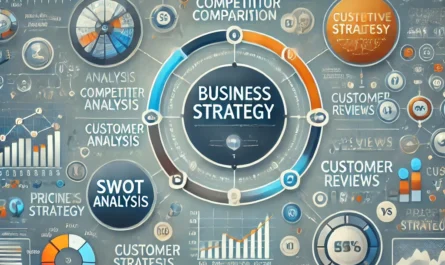In the world of business, profitability is the ultimate goal. Whether you’re a small startup or a large corporation, optimizing your business strategy to maximize profit requires a fine balance between planning, execution, and adaptation. A well-rounded strategy aligns all aspects of the business, from customer relationships and market positioning to operational efficiency and cost management. This guide provides a comprehensive look at the steps and considerations necessary to elevate your business strategy for greater profitability.
Understanding Business Strategy
Your business strategy is essentially the roadmap for achieving your organization’s goals. It’s about making deliberate choices about how you will compete in the marketplace and deliver value to your customers. Profitability, of course, sits at the heart of a successful business strategy, but reaching it depends on several factors.
Core Elements of a Business Strategy
A robust business strategy consists of various core elements that work together harmoniously. These include:
- Vision and Mission: What is the purpose of your business, and where do you want it to go? These guiding principles help shape strategic decisions.
- Market Positioning: How does your business differentiate itself from competitors? This aspect focuses on offering unique value.
- Operational Efficiency: Ensuring that your resources—time, labor, and materials—are used effectively is crucial to maintaining profitability.
- Customer Targeting: Knowing your audience and tailoring your products and services to meet their needs ensures long-term business viability.
The Role of Profitability in Business Success
Profitability isn’t just about high revenues; it’s about finding the right balance between revenue generation and cost management. Profits provide businesses with the fuel for innovation, expansion, and financial sustainability. Without profitability, even the most visionary business will struggle to survive in a competitive market.
Identifying Key Profitability Drivers
A clear understanding of what drives profitability is essential to building a sustainable business. Let’s dive into the key drivers that significantly influence your bottom line.
Revenue Growth Opportunities
Growing revenue doesn’t happen by accident—it’s the result of strategically identifying and pursuing opportunities. This may involve expanding into new markets, creating additional revenue streams, or improving sales efforts.
To explore revenue growth:
- Identify untapped customer segments
- Offer complementary products or services
- Focus on upselling and cross-selling to current customers
Cost Efficiency and Management
Controlling costs is just as important as increasing revenue. For many businesses, optimizing expenses is the quickest way to improve profitability. Evaluate every process to identify inefficiencies or areas where cost savings can be achieved without sacrificing quality.
Balancing Risk and Innovation
Innovation is key to maintaining competitive advantage, but it also comes with risks. Successfully balancing these two factors is critical to ensuring that your innovation efforts drive profitability, not losses. Businesses that take calculated risks by investing in research and development (R&D), exploring new technologies, and embracing market disruptions often see long-term gains.
Setting Clear, Achievable Goals
A business without clear, defined goals is like a ship sailing without a destination. To optimize profitability, it’s crucial to set goals that are both ambitious and realistic.
SMART Goals for Business Growth
The SMART framework (Specific, Measurable, Achievable, Relevant, and Time-bound) is an effective way to set actionable goals. For instance, a goal to increase sales by 10% over the next six months is not only measurable but also gives your team a clear objective to work toward.
Aligning Financial Objectives with Long-term Strategy
Your financial goals should align with your long-term vision. If your business is focused on aggressive growth, short-term sacrifices in profitability might be necessary. Conversely, if sustainability is a priority, more conservative financial goals that emphasize steady revenue growth may be more appropriate.
Analyzing Market Trends for Strategic Advantage
Understanding and capitalizing on market trends can be the difference between thriving and merely surviving. A deep dive into market research can help your business stay ahead of competitors and respond to shifts in customer needs.
Market Research and Competitive Analysis
Regularly conducting market research ensures you stay informed about industry developments, customer preferences, and competitors’ strategies. This enables you to pivot quickly and take advantage of new opportunities as they arise.
Identifying and Responding to Customer Needs
Customers are the lifeblood of your business, and satisfying their needs is a prerequisite for profitability. Continuously engaging with your audience through surveys, feedback channels, and market analysis helps you understand their evolving expectations, allowing you to adjust your strategy accordingly.
Leveraging Industry Trends for Competitive Edge
Staying ahead of industry trends—whether they relate to technology, customer preferences, or regulations—enables businesses to innovate and adapt their offerings. Those that are agile in response to market conditions tend to reap the rewards in profitability.
Optimizing Operations for Efficiency
Operations are often an overlooked area when it comes to profitability. However, even small changes in process efficiency can lead to significant cost reductions.
Streamlining Processes for Cost Reduction
Reducing waste and inefficiency in business processes can provide immediate financial benefits. Evaluate areas such as production, supply chain management, and administrative workflows to identify potential improvements.
You can also read; How to Improve Business Performance with SWOT
Automation and Technology Implementation
Automation isn’t just about replacing human labor; it’s about enhancing efficiency and productivity across the board. Implementing technologies such as AI, machine learning, and software systems can significantly reduce errors and optimize performance.
Stay tuned for more insights on improving customer relationships, financial management, and sustainable growth in the following sections. Continue reading for actionable tips and FAQs to help you further optimize your business strategy for maximum profitability!



